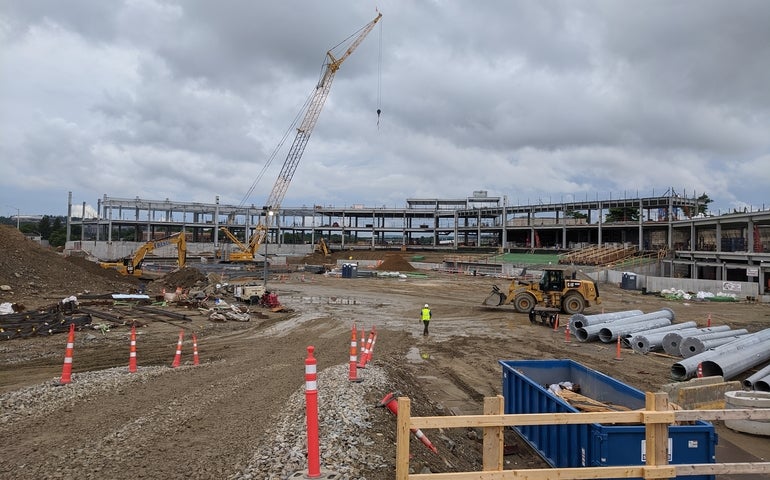Before construction even began, a timetable for completing Polar Park, a new minor league baseball stadium in Worcester, was called ambitious by those planning it.
Despite a pause in construction lasting about a month during the height of the coronavirus pandemic, planners are still holding out hope: the Worcester Red Sox will begin playing at the ballpark in April 2021.
“Until we have a new plan, that’s our plan,” said Janet Marie Smith, a prominent ballpark architect who is acting as a consultant on the $132-million project.
Smith and leading officials from the City of Worcester and the WooSox — who will play one more season in Pawtucket, R.I., if games are held — gave a media tour of Polar Park on Monday to show progress evident in various areas. Concrete has been poured for a 22-foot wall in right field, and a seating bowl is taking shape around the infield. Union Station is visible from the concourse behind where home plate will go.
Steel rising off Madison Street in the past few months will remain a visible component of the ballpark, a nod to the city’s industrial history. Other Worcester quirks include heart designs on the top of light towers, in a clear allusion to the city’s nickname as the Heart of the Commonwealth.
Design work is almost entirely complete, but architects remain working on smaller details, Smith said. The ballpark is planned to have a capacity for 10,000, with about 6,000 fixed seats and the remainder a mix of tables, seating berms and other areas.
“I don’t think you ever really finish designing,” she said.
The project hasn’t gone entirely smoothly since city officials and the team announced plans to move to Worcester in August 2018.
Aside from the pandemic-related delay, construction costs have risen by roughly $30 million, due to higher material costs and site acquisition. The city, which will own the ballpark and is paying for most of the project, picked up about $20 million of those extra costs.
City officials have maintained the ballpark, which the city is borrowing funds for over a 30-year period, will pay for itself through new property tax revenue on sites surrounding the ballpark. Much of that revenue would come from a multi-building mixed-use development on the other side of Madison Street, including a dual-branded hotel with 262 rooms, a 121,000-square-foot commercial building, a 60,000-square-foot commercial building, and a 125-unit residential building. Work on that project has yet to start. The first phase of the development was originally said to open by Jan. 1, 2021.
Looking to further push along that project, the Worcester City Council has approved a series of tax breaks, including for the hotels, another for a residential building, and a third for a building calling for office, laboratory and retail use.
A sudden recession has called into question the shorter-term viability of those buildings or an office building slated to be a landmark of sorts for Polar Park beyond the left field wall. Concrete has been poured for underground parking, but the office building will not be built for opening day as envisioned. Plans now call for capping the underground garage and building the office building later.
“It depends on market conditions,” Smith said of the construction.
Sports economists, including those who’ve reviewed financing for Polar Park, have nearly unanimously said such public funding isn’t a wise use of funds because economic impacts of stadiums are relatively small.
For an afternoon at least, a tour taking place between bouts of rain offered city and team leaders a chance to push those concerns for another time and show off what they say will be a magnet for visitors.
“You can picture the 10,000 people before and after the game just pouring in and out and filling the Canal District with life,” said Charles Steinberg, the team president.
City Manager Edward Augustus stood at the top of Gold Street beyond the ballpark’s right field and envisioned the public being able to see into the ballpark even when games aren’t played.
“This is the money shot,” he said. “This is going to be an amazing vantage point.”

